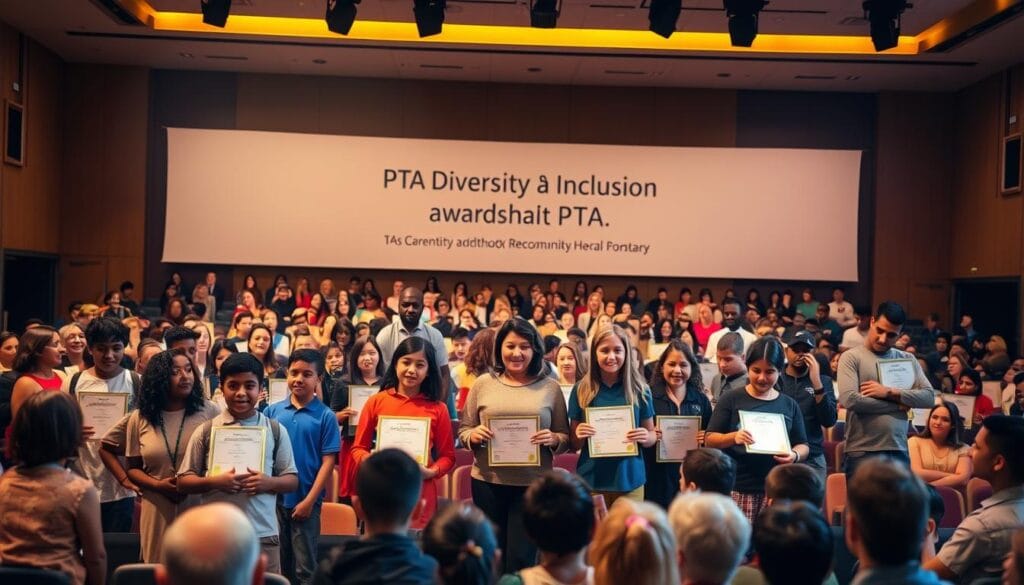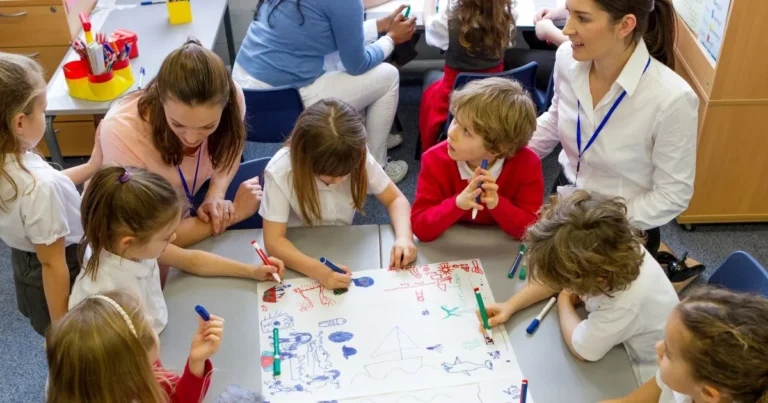Parent Teacher Association Programs That Make a Difference
Ever thought about how parent teacher association programs change your child’s school life? It’s amazing when parents and teachers work together. They build a strong support system that helps students succeed.
Studies show a big truth: kids with involved parents through PTAs get up to 25% better grades. These efforts are more than just meetings and fundraisers. They change how schools and communities work together.
PTAs help connect home and school, letting families directly impact their kids’ learning. By joining these programs, you support your child and help the whole school community.
Schools with active PTAs see big improvements. Attendance goes up by 10-15%, and bad behavior drops by about 20%. Student interest also grows a lot. These numbers show how powerful parent-teacher partnerships can be.
Your help is crucial. PTAs make students feel part of a community, improve their social and emotional skills, and offer important resources. By getting involved, parents become true champions of education.
Table of Contents
Understanding the Role of PTAs in Modern Education
Parent Teacher Associations (PTAs) have been key in changing how students learn in the United States. These groups are important because they connect schools and families. This connection helps students succeed.
Historical Evolution of Parent-Teacher Partnerships
PTAs started 124 years ago to improve education through parental help. Over time, they have grown to meet new needs and challenges in education.
- Late 19th-century origins focused on basic educational support
- The mid-20th century saw expanded advocacy roles
- Modern PTAs address comprehensive student development
Core Mission and Values
PTAs aim to make learning better for students. Studies show they make a big difference. Schools with PTAs see a 20% boost in grades and a 10% jump in attendance.
| PTA Impact Metrics | Percentage Improvement |
|---|---|
| Academic Performance | 20% |
| School Attendance | 10% |
| Behavioral Issues Reduction | 25% |
| Parent Satisfaction | 30% |
Key Stakeholders in PTA Success
PTAs need many people to work well. This includes parents, teachers, school leaders, and community members. They make sure everyone has a chance to help out.
- Parents provide critical support and perspective
- Teachers offer educational expertise
- Administrators facilitate strategic implementation
- Community members bring additional resources
PTAs are changing education by working together and finding new ways to help. They make a big difference in schools across the country.
Parent Teacher Association Programs That Transform Schools
Parent Teacher Associations are key in making schools lively through new programs and plans. They do more than just help with schoolwork. They make learning fun and full for students.
PTAs change schools in big ways, focusing on events and activities outside of class. They help schools get what they need and make learning fun.
Key Transformation Strategies
- Develop targeted fundraising events supporting critical school needs
- Create diverse extracurricular activities promoting student engagement
- Foster social-emotional development through community programs
- Provide financial support for classroom materials and student experiences
PTAs use proven programs to make a big difference. For example, a California PTA helped with gardening and a Read-a-Thon. This gave schools what they needed for learning.
In Vermont, PTAs support artists and live shows. This makes learning more exciting for students.
Your local PTA can change schools for the better. They do this through events, volunteering, and new ideas. These efforts help students succeed in school.
Impact Highlights
| Program Type | Primary Benefit |
|---|---|
| Fundraising Events | Resource Generation |
| Extracurricular Activities | Student Skill Development |
| Community Engagement | Social-Emotional Learning |
Good PTAs are flexible, creative, and care about students’ success.
STEM + Families Initiative: Inspiring Future Innovators
The STEM + Families Initiative is a new way to support students and engage families. It connects education with real-world innovation. This lets families explore science together.
Students from underprivileged areas often struggle to get a good STEM education. This program helps by making learning fun and inclusive. It sparks curiosity and inspires the next generation of innovators.
Engineering Design Challenges
Our program offers exciting engineering design challenges. These make learning a fun family adventure. Families can:
- Work together on hands-on projects
- Improve their critical thinking
- Discover new tech solutions
Career Exploration Activities
Students learn about cool STEM careers through our family engagement strategies. The initiative includes:
- Mentorship from STEM experts
- Interactive workshops on different careers
- Job shadowing opportunities
Family Engagement Through Science
We make science a part of family activities. This creates lively learning spaces. Our approach includes:
| Activity Type | Learning Outcome |
|---|---|
| Home Experiments | Practical Scientific Understanding |
| Nature Exploration | Environmental Awareness |
| Technology Workshops | Digital Literacy Skills |
Studies show that positive STEM experiences boost kids’ interest and confidence in science. By making learning fun and inclusive, we’re laying the groundwork for future innovation.
Diversity and Inclusion Awards Program

The National PTA’s Diversity and Inclusion Awards show a strong commitment to welcoming schools. They honor PTAs who stand up for diversity. These awards show how important it is for schools to be inclusive.
In 2024, three PTAs were given the Jan Harp Domene Diversity and Inclusion Award:
- Mill Creek Elementary PTA
- Big Creek Elementary PTA
- Hollandale PTSA
These PTAs show great teamwork that celebrates diversity. They show how PTAs can change school cultures:
- Mill Creek Elementary PTA made schools more accessible with free events and language support
- Big Creek Elementary PTA got more people to events and made the board more diverse
- Hollandale PTSA involved grandparents raising their grandkids in school activities
Winners get a plaque and $1,000. The National PTA picks them for their hard work in making schools fair for everyone.
Building Strong School Communities Through PTA Events
Parent-Teacher Associations are key in making school communities lively. They do this through engaging events and teamwork. Your school’s PTA can make learning better by hosting fundraising events, workshops, and family activities.
Good PTAs know how to build strong school communities. They focus on getting families involved and raising funds. This support is vital for better education.
Fundraising Activities
Fundraising is crucial for supporting school programs and creating fun community events. Some effective ways include:
- Annual charity auctions
- Community fun runs
- Online donation campaigns
- Seasonal merchandise sales
Studies show that fundraising can bring in $1,500 to $3,000 per event. This money is essential for school projects.
Educational Workshops
Educational workshops are great for learning. They help parents, teachers, and students learn more. These sessions fill knowledge gaps and improve education.
| Workshop Type | Target Audience | Key Benefits |
|---|---|---|
| Digital Literacy | Parents | Understanding modern learning technologies |
| STEM Strategies | Teachers | Innovative teaching methodologies |
| College Preparation | Students | Application and scholarship guidance |
Family Engagement Initiatives
Family engagement is vital for a supportive learning environment. PTAs can start programs that get everyone involved:
- Monthly parent-teacher networking events
- Virtual conference platforms
- Collaborative learning workshops
- Cultural celebration days
Up to 70% of parents say they get more involved in school after PTA events. This shows how powerful community connection can be.
Implementing Successful Communication Strategies
Effective communication is key to a strong partnership between parents and schools. Studies show that regular communication can cut misunderstandings by up to 70%. Your Parent-Teacher Association (PTA) can boost school engagement with the right communication strategies.
Here are some important strategies for better communication:
- Use multilingual communication platforms
- Take advantage of digital tools
- Make information easy to find
- Keep messages clear and consistent
Schools that make language accessible see a 40% jump in parent involvement. TalkingPoints, a platform for over 150 languages, shows the value of inclusive communication.
Building strong partnerships needs a variety of approaches. Try these communication methods:
- Send out weekly digital newsletters
- Offer bilingual resources
- Make school websites interactive
- Use social media to engage
Good communication can help students do better. About 85% of parents say updates help them support their child’s learning. PTAs can make communication clear and accessible, bringing the school community closer together.
Measuring Program Impact and Success
Understanding how well Parent-Teacher Association (PTA) programs work is key. By looking at different metrics, PTAs can show how much they help students. This includes support in school and outside activities.
Success in PTA programs is about more than just grades. It’s about how students grow and how they connect with their community. Studies prove that when PTAs are active, students do better.
Academic Achievement Indicators
There are important signs of how well a program works:
- Standardized test score improvements
- Grade point average progression
- Student attendance rates
- Homework completion percentages
Community Engagement Metrics
| Metric Category | Measurement Approach |
|---|---|
| Parent Participation | Event attendance, volunteer hours |
| Extracurricular Activities | Student enrollment, program diversity |
| Community Partnerships | Collaborative initiatives, resource sharing |
Student Development Outcomes
Looking at how students grow is important. The holistic assessment covers:
- Social-emotional skill development
- Leadership capabilities
- Personal confidence
- Interpersonal communication skills
By checking these many signs, PTAs can get better at helping students. They can make learning experiences more meaningful.
Resources and Support for PTA Leaders

Leading a parent-teacher association is a big job. It needs the right support and tools. The National PTA, with 120 years of experience, provides top-notch help. They focus on making schools better through volunteer work.
PTA leaders have access to many resources. These include:
- Professional development training programs
- Networking platforms for knowledge exchange
- Comprehensive leadership guides
- Online learning modules
Good communication is key for PTA success. Tools like websites, email newsletters, and social media are great. They help leaders talk to parents, teachers, and school staff easily.
Getting volunteers is crucial for PTA success. Here are some tips:
- Create welcoming onboarding experiences
- Offer flexible engagement opportunities
- Recognize volunteer contributions
- Provide clear expectations and support
Your leadership can change school communities for the better. Use these resources and build strong partnerships.
Conclusion
Exploring parent teacher association programs shows a strong way to improve school community involvement. Studies show that when parents get involved, students can do up to 30% better in school. This shows how important PTAs are for learning.
Joining parent teacher association programs can really help your child in school. Research says 78% of teachers think meetings with parents are key to building trust. Your help makes a school a better place for learning and feeling good.
PTAs do more than just help with homework. They help make schools better places for kids to learn and grow. When parents and teachers work together, kids can grow a lot more.
Start today by looking into PTAs in your area. Your effort can make a big difference for kids. Together, we can make sure every child gets the chance to succeed.








